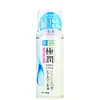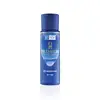What's inside
What's inside
 Key Ingredients
Key Ingredients

 Benefits
Benefits

 Concerns
Concerns

 Ingredients Side-by-side
Ingredients Side-by-side

Water
Skin ConditioningGlycerin
HumectantCaprylic/Capric Triglyceride
MaskingDipropylene Glycol
HumectantSqualane
EmollientC20 Olefin
PPG-10 Methyl Glucose Ether
Skin ConditioningHydrolyzed Hyaluronic Acid
HumectantSodium Hyaluronate
HumectantPEG-20 Sorbitan Isostearate
EmulsifyingGlyceryl Stearate
EmollientDimethicone
EmollientStearyl Alcohol
EmollientCarbomer
Emulsion StabilisingBehenyl Alcohol
EmollientPhytosteryl/Octyldodecyl Lauroyl Glutamate
Skin ConditioningMelaleuca Alternifolia Leaf Oil
AntioxidantDisodium EDTA
Methylparaben
PreservativePropylparaben
PreservativeWater, Glycerin, Caprylic/Capric Triglyceride, Dipropylene Glycol, Squalane, C20 Olefin, PPG-10 Methyl Glucose Ether, Hydrolyzed Hyaluronic Acid, Sodium Hyaluronate, PEG-20 Sorbitan Isostearate, Glyceryl Stearate, Dimethicone, Stearyl Alcohol, Carbomer, Behenyl Alcohol, Phytosteryl/Octyldodecyl Lauroyl Glutamate, Melaleuca Alternifolia Leaf Oil, Disodium EDTA, Methylparaben, Propylparaben
Tranexamic Acid
AstringentHydrolyzed Hyaluronic Acid
HumectantSodium Acetylated Hyaluronate
HumectantMagnesium Ascorbyl Phosphate
AntioxidantTocopherol
AntioxidantCoix Lacryma-Jobi Ma-Yuen Seed Extract
Skin ConditioningButylene Glycol
HumectantDipropylene Glycol
HumectantHydrogenated Polydecene
EmollientPentylene Glycol
Skin ConditioningGlycerin
HumectantDiglycerin
HumectantLimnanthes Alba Seed Oil
Skin ConditioningSorbitan Stearate
EmulsifyingPolysorbate 80
EmulsifyingCarbomer
Emulsion StabilisingDisodium EDTA
Hydroxyethylcellulose
Emulsion StabilisingGlyceryl Caprylate/Caprate
EmollientXanthan Gum
EmulsifyingBehenyl Alcohol
EmollientPhenoxyethanol
PreservativeTranexamic Acid, Hydrolyzed Hyaluronic Acid, Sodium Acetylated Hyaluronate, Magnesium Ascorbyl Phosphate, Tocopherol, Coix Lacryma-Jobi Ma-Yuen Seed Extract, Butylene Glycol, Dipropylene Glycol, Hydrogenated Polydecene, Pentylene Glycol, Glycerin, Diglycerin, Limnanthes Alba Seed Oil, Sorbitan Stearate, Polysorbate 80, Carbomer, Disodium EDTA, Hydroxyethylcellulose, Glyceryl Caprylate/Caprate, Xanthan Gum, Behenyl Alcohol, Phenoxyethanol
Ingredients Explained
These ingredients are found in both products.
Ingredients higher up in an ingredient list are typically present in a larger amount.
Behenyl Alcohol is a type of fatty alcohol (these are different from the drying, solvent alcohols).
Fatty Alcohols have hydrating properties and are most often used as an emollient or to thicken a product. They are usually derived from natural fats and oils; behenyl alcohol is derived from the fats of vegetable oils.
Emollients help keep your skin soft and hydrated by creating a film that traps moisture in.
In 2000, Behenyl Alcohol was approved by the US as medicine to reduce the duration of cold sores.
Learn more about Behenyl AlcoholCarbomer is a polymer of acrylic acid. Its main role is to create a gel consistency.
A high amount of carbomer can cause pilling or balling up of products. Don't worry, most products contain 1% or less of carbomer.
Dipropylene Glycol is a synthetically created humectant, stabilizer, and solvent.
This ingredient helps:
Dipropylene glycol is technically an alcohol, but it belongs to the glycol family (often considered part of the ‘good’ alcohols). This means it is hydrating and gentle on skin unlike drying solvent alcohols like denatured alcohol.
As a masking agent, Dipropylene Glycol can be used to cover the smell of other ingredients. However, it does not have a scent.
Studies show Dipropylene Glycol is considered safe to use in skincare.
Learn more about Dipropylene GlycolDisodium EDTA plays a role in making products more stable by aiding other preservatives.
It is a chelating agent, meaning it neutralizes metal ions that may be found in a product.
Disodium EDTA is a salt of edetic acid and is found to be safe in cosmetic ingredients.
Learn more about Disodium EDTAGlycerin is already naturally found in your skin. It helps moisturize and protect your skin.
A study from 2016 found glycerin to be more effective as a humectant than AHAs and hyaluronic acid.
As a humectant, it helps the skin stay hydrated by pulling moisture to your skin. The low molecular weight of glycerin allows it to pull moisture into the deeper layers of your skin.
Hydrated skin improves your skin barrier; Your skin barrier helps protect against irritants and bacteria.
Glycerin has also been found to have antimicrobial and antiviral properties. Due to these properties, glycerin is often used in wound and burn treatments.
In cosmetics, glycerin is usually derived from plants such as soybean or palm. However, it can also be sourced from animals, such as tallow or animal fat.
This ingredient is organic, colorless, odorless, and non-toxic.
Glycerin is the name for this ingredient in American English. British English uses Glycerol/Glycerine.
Learn more about GlycerinHydrolyzed Hyaluronic Acid is a form of hyaluronic acid. It is created by the hydrolysis of hyaluronic acid with a high molecular weight. Once created, Hydrolyzed Hyaluronic Acid has a low molecular weight.
Low molecular weight HA has been shown to hydrate and increase elasticity of the skin. Increasing elasticity is also associated with reduction of wrinkle depth.
One study found topical low molecular weight hyaluronic acid may be considered for the treatment of rosacea in the adult population. However, we always recommend speaking with a professional about your skin concerns.
Hyaluronic acids are a humectant. This means they draw moisture from the air. Hyaluronic acids help moisturize, soothe, and protect the skin.
Read more about other common forms of hyaluronic acid:
Learn more about Hydrolyzed Hyaluronic Acid